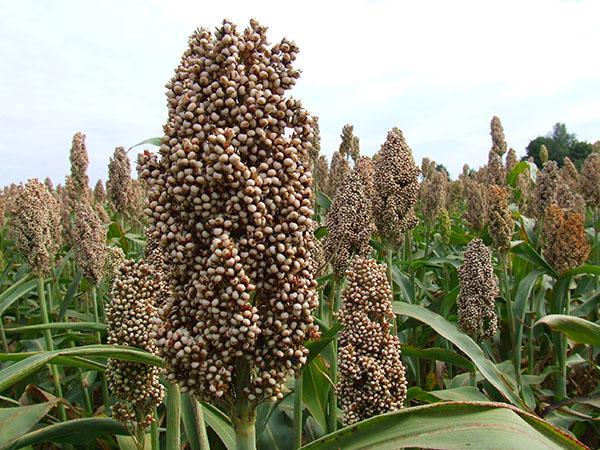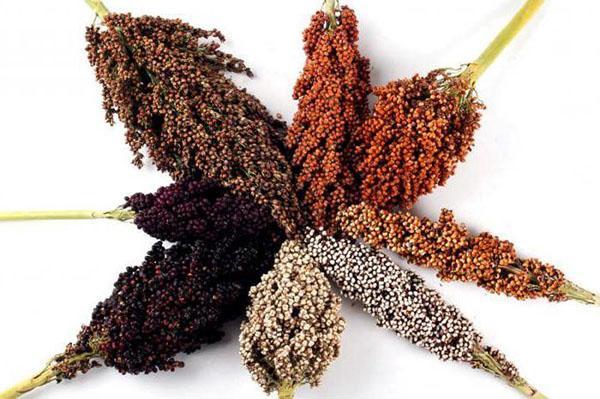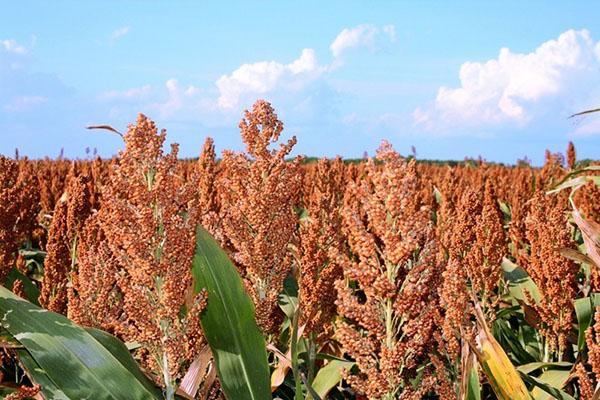Competent technology of growing grain sorghum is the key to a high and stable crop yield
 Sorghum is a valuable food and fodder crop due to its high yield, versatility in application, resistance to soil and air drought, and low demands on soil quality. This publication will describe in detail the technology of growing grain sorghum, especially the care and protection of crops from pests.
Sorghum is a valuable food and fodder crop due to its high yield, versatility in application, resistance to soil and air drought, and low demands on soil quality. This publication will describe in detail the technology of growing grain sorghum, especially the care and protection of crops from pests.
Features and areas of application of culture

The natural conditions for the cultivation of sorghum are areas with a hot climate. The native land of the plant is Northeast Africa. Today, the main producers of this cereal are Nigeria, Mexico, India, and the southern states of the United States. This is not surprising, because sorghum is a thermophilic crop characterized by high drought resistance.
Grain sorghum seeds are collected in dense bunches (panicles).
 Seed color varies from light yellow to black-brown. The ground part is covered with a thin waxy film that reduces moisture evaporation. The plant is undersized, up to 1.5 m high. The stem is powerful with a dry core. The leaf is green with a light colored central vein. The plant has a powerful fibrous root system that penetrates the soil to a depth of 1.5 meters. Due to its structure, sorghum shows high productivity both on heavy clay soils and light sandy soils with a high salt content.
Seed color varies from light yellow to black-brown. The ground part is covered with a thin waxy film that reduces moisture evaporation. The plant is undersized, up to 1.5 m high. The stem is powerful with a dry core. The leaf is green with a light colored central vein. The plant has a powerful fibrous root system that penetrates the soil to a depth of 1.5 meters. Due to its structure, sorghum shows high productivity both on heavy clay soils and light sandy soils with a high salt content.
In the Crimea and the Caucasus, the yield of grain sorghum reaches 40 centners / ha. In the middle zone of the Russian Federation, the yield of sorghum per hectare varies in the region of 12-20 centners.
The field of application of the plant is extensive. Concentrated feed for farm animals is produced from stems and leaves. From the seeds of the culture they produce:
- flour;
- starch;
- alcohol.
In recent years, the cereal has received high praise from nutritionists who recommend including sorghum in the daily diet of people who are prone to overweight. The energy value of the product is 340 kl. 100 g of cereal contains 15 g of protein, 68 g of carbohydrates, 4 g of fat. Vitamins H and PP promote the breakdown of fat cells and accelerate metabolic processes in the human body.
The seeds of the plant practically do not contain gluten - a protein, intolerance to which is registered in 3% of the adult population and in 5% of children.
"No-Till" - an effective technology for growing grain sorghum
This technology of growing sorghum for grain includes several stages.
Agroplanning
 With competent planning of crops, the crop rotation pattern and the degree of soil contamination must be taken into account. In the first month, the crop shows a slow growth rate, which allows weeds to significantly reduce yields.
With competent planning of crops, the crop rotation pattern and the degree of soil contamination must be taken into account. In the first month, the crop shows a slow growth rate, which allows weeds to significantly reduce yields.
Grain sorghum is a plant that is not demanding on its predecessors. Nevertheless, as practice has shown, it is better to plant cereals after crops that leave a sufficient amount of moisture and nutrients in the soil: wheat, barley, fodder beets and oats. Allowed as predecessors: corn, sunflower.
Seed material
 For sowing, seeds are used, most often, of domestic selection.This technology of growing grain sorghum involves the use of weed control, soil irrigation with herbicide "Primekstra TZ Gold 500". In this case, the entire seed stock must be treated with Concept antidote.
For sowing, seeds are used, most often, of domestic selection.This technology of growing grain sorghum involves the use of weed control, soil irrigation with herbicide "Primekstra TZ Gold 500". In this case, the entire seed stock must be treated with Concept antidote.
2 months before sowing, the seeds must be treated with special combined agents ("Fentiuram" and others) in order to exclude the influence of pathogenic microflora and pests on the planting material.
Soil preparation
 Pre-sowing soil preparation is aimed at maximum moisture retention and weed control. Early spring harrowing is considered the most effective way to retain moisture in the soil.
Pre-sowing soil preparation is aimed at maximum moisture retention and weed control. Early spring harrowing is considered the most effective way to retain moisture in the soil.
Before sowing seeds, continuous action chemicals based on glyphosphate are introduced into the soil. Depending on the product, the average application rate is 2 l / ha. This is necessary for the destruction of weeds.
After applying the herbicide, two cultivations are carried out:
- Accelerates soil heating, removes etched weed vegetation, eliminates crust formation with excessive soil moisture.
- Carried out just before landing.
When pre-sowing soil fertilization, you should not apply nitrogen and phosphorus additives at the same time. This "neighborhood" has a negative impact on seed germination.
Sowing technology
 The planting time of seeds depends on the soil temperature. Sowing begins at soil temperature at a depth of 10 cm from + 12 ° to + 15 ° C.
The planting time of seeds depends on the soil temperature. Sowing begins at soil temperature at a depth of 10 cm from + 12 ° to + 15 ° C.
Sorghum is sown in a dotted manner to a depth of 5-7 cm with a row spacing of 38 and 45 cm. The grain should lie on hard and moist soil. A wide-row method with a row spacing of 60-70 cm is practiced. As practice has shown, the best yields were achieved when sowing with a row spacing of 45 and 60 cm. It is better to sow cereal seeds using a multi-disc seeder. The seeding rate of sorghum per hectare is on average 10-14 kg to obtain a planting density of 160-170 thousand plants per hectare. Simultaneously with the seeds, diammofosk fertilizers are introduced into the soil.
Immediately after sowing, the seeds must be applied to the soil herbicide "Primekstra TZ Gold 500" subject to pretreatment of the planting material with an antidote.
Culture care
 At an average soil temperature of + 15 ° C, sorghum shoots appear on the 10-12th day. An increase in temperature indicators reduces the process of seedling emergence to 5-6 days. With this technology of growing grain sorghum, the care of crops is to combat weeds and pests.
At an average soil temperature of + 15 ° C, sorghum shoots appear on the 10-12th day. An increase in temperature indicators reduces the process of seedling emergence to 5-6 days. With this technology of growing grain sorghum, the care of crops is to combat weeds and pests.
When 3-5 true leaves appear at seedlings, it is necessary to carry out the process of irrigating the soil with a herbicide in order to destroy vegetative weeds. The drugs have shown good efficiency: "Peak"; Prima. The application rate is calculated depending on the planting density and the degree of soil contamination. In some cases, additional harrowing is carried out, which makes it possible to destroy up to 85% of weeds.
Experts do not recommend the introduction of herbicides at the later stages of sorghum ripening.
To combat cereal aphids, an insect that causes the greatest harm to cereal plants, crops are treated with insecticides. An excellent result was shown by preparations: "Nurel", "BI-58" with a rate of 0.7 to 1 l / ha.
Sorghum harvest
 The harvesting process is started upon reaching technical maturity and a certain moisture content of the grains, using the method of direct combining with a cut of only the upper part of the plant. In this case, the grains in the panicle should have uniform ripening, and their moisture content should be within 25%.
The harvesting process is started upon reaching technical maturity and a certain moisture content of the grains, using the method of direct combining with a cut of only the upper part of the plant. In this case, the grains in the panicle should have uniform ripening, and their moisture content should be within 25%.
Early maturing varieties of grain sorghum are harvested in a separate way with low mowing to a height of 15 cm from the ground. The crop is folded into rolls to reduce grain moisture to 14%. Only after this is the process of threshing, transportation for storage and processing carried out.